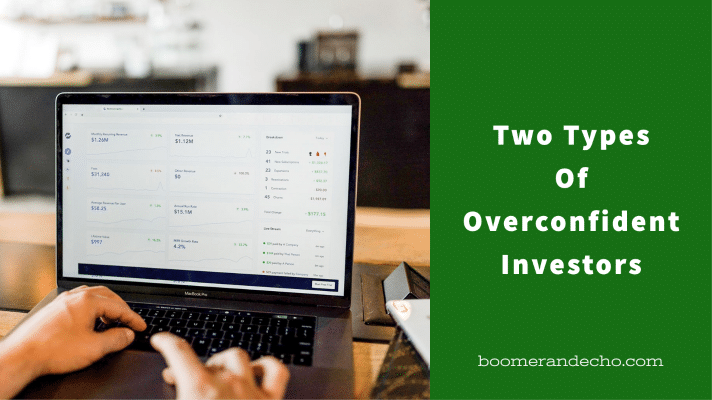Two Types Of Overconfident Investors

I started investing in individual stocks shortly after the Great Financial Crisis ended in 2009. I picked an investing strategy that closely resembled the Dogs of the TSX, buying the 10 highest yielding Canadian dividend stocks. As you can imagine, the share prices of these companies got hammered during the stock market crash so I was able to scoop up shares in banks, telecos, pipelines, and REITs on the cheap.
Stocks came roaring back right away and my portfolio gained 35% by the end of 2009. Investing is easy, right?
It took me a while to figure out that my portfolio returns had less to do with my stock picking prowess and more to do with market conditions, luck, and the timing of new contributions. The rising tide lifted all ships, including my handful of Canadian dividend stocks.
I started comparing my returns to an appropriate benchmark to see if my judgement was adding any value over simply buying a broad market index fund. My portfolio outperformed for a few years until it didn’t. In 2015, I had enough and switched to an index investing strategy. Now I invest in Vanguard’s All Equity ETF (VEQT) across all of my accounts.
Related: Exactly How I Invest My Money
New investors who started trading stocks recently may have had a similar experience. After an “everything is down” year in 2022, stocks have rallied big-time over the past 20 months.
For the period of January 1st, 2023 to August 31st, 2024 the S&P 500 (represented by Vanguard’s VFV) is up 50% including dividends. The Canadian market (represented by Vanguard’s VCN) is up 28% including dividends. And a portfolio of global stocks (represented by Vanguard’s VEQT) is up 36%.
Those are specific market indexes, mind you. Over the same time period, individual stocks like NVIDIA and Super Micro Computer are up 717% and 433% respectively. Tesla (+74%), Microsoft (+76%), and Apple (+78%) continue to shine. Even meme stock darling GameStop is up 27%.
No doubt, unless they’ve done something disastrous, new investors participating in this market have seen incredible returns so far.
This can lead to overconfidence – when people’s subjective confidence in their own ability is greater than their objective (actual) performance.
Larry Swedroe says the biggest risk confronting most investors is staring at them in the mirror. This is the first type of overconfident investor.
Overconfidence causes investors to trade more. It helps reinforce a belief that any investment wins are due to skill while any failures are simply bad luck. According to Swedroe, individual investors tend to trade more after they experience high stock returns.
Overconfident investors also take on more uncompensated risk by holding fewer stock positions.
Furthermore, overconfident investors tend to rely on past performance to justify their holdings and expectations for future returns. But just because stocks have soared over the past 20 months doesn’t mean that performance will continue over the next 20 months.
In fact, you should adjust your expectations for future returns – especially for individual stocks that have increased by 100% or more. No stock, sector, region, or investing style stays in favour forever. If you tilt your portfolio to yesterday’s winners (US large cap growth stocks) there’s a good chance your portfolio will underperform over the next decade.
The second type of overconfident investor is one who makes active investing decisions based on a strong conviction about how future events will unfold.
Related: Changing Investment Strategies After A Market Crash
Think back to the start of the pandemic. As businesses shut down around the world it seemed obvious that global economies would suffer and fall quickly into a massive recession. The stock market crash reinforced that idea. Investors hate uncertainty, but this time it seemed a near certainty that stock markets would continue to fall and remain in a prolonged bear market.
Markets quickly turned around as central banks and governments doled out massive stimulus to keep their economies afloat and their citizens safe at home. Now it became ‘obvious’ that investing in sectors like groceries, cleaning supplies, online commerce, and video technology would produce strong results.
Fast forward a year or two when high inflation became a chief concern. Some investors, overconfident in the outcome of sustained higher inflation, shifted their portfolio into so-called inflation hedges. These could include gold, cryptocurrency, inflation-protected bonds, commodities, or real estate.
But as Ben Felix pointed out in this episode of the Rational Reminder podcast, the ultimate inflation hedge is a globally diversified and risk appropriate portfolio (and even that’s not really a hedge).
Finally, there are the perma-bears who claim the next great crash is right around the corner. These overconfident investors aim to avoid losses and protect their downside by making active bets with their portfolio. This could include selling stocks and moving to cash, using alternative investments that have low correlation to stock performance, buying put options, or short selling stocks.
The point is, they claim to know what’s coming and how to avoid it.
Reasonable critics (like me) would agree that stock valuations, especially US stocks, are high. We would agree that there’s always the possibility of a stock market crash. What I’d disagree with is what to do about it. If you’re invested in a globally diversified and risk appropriate portfolio, the answer is to lower your expected future return assumptions and do nothing else.
Final Thoughts
Overconfidence is something that most investors have to deal with at some point in their journey. I argue that there are actually two types of overconfident investors.
The first type is when you believe your past investing performance has more to do with your skill and decision making than with luck, timing, and market conditions.
The second type is when you believe you can correctly predict a future (macro) outcome and you make active decisions with your investments to support that belief.
You can avoid the first type of overconfidence by diligently comparing your investment returns with an appropriate benchmark index. I did this with my Canadian dividend stocks by comparing the performance to the iShares Canadian Dividend Aristocrats Index ETF (CDZ).
This process helped open my eyes to how difficult it is to actually beat the market on a consistent basis. I eventually gave up stock picking and switched to indexing – accepting market returns in exchange for a tiny fee.
The second type of overconfidence is much more difficult to overcome. We can’t help but make predictions about the future, or listening to pundits who make a living sharing their predictions. Even if we don’t have strong convictions about the future, we can easily be swayed into doing something with our investments to stickhandle around future outcomes.
This is where I find comfort investing in an asset allocation ETF. When I invested in individual stocks I could see plain as day which ones were in the red (looking at you, oil & gas stocks). Even with a multi-ETF portfolio you can see which one(s) are underperforming and you can easily second guess your holdings or target asset mix.
With an asset allocation ETF you don’t see the underlying holdings. It all moves together in a perfectly balanced and targeted mix. This way, I find myself less likely to want to tinker with my portfolio when it’s all rolled up into one investment.






